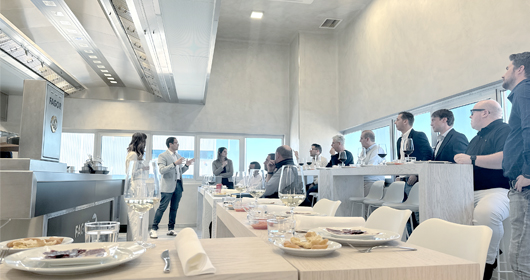The Nordic countries have been successfully using the Halton Vita OR Space 5 for air ventilation in operating theatres for years. This system is very popular because it provides maximum flexibility. However, operating theatres in the Netherlands have only been equipped with this system this year. It concerns the OR complex of the Nij Smellinghe hospital in Drachten. The reason they waited with this in the Netherlands is that there was no clear guideline for the certification, but that is all in the past now thanks to cooperation between Halton and Kalibra.
What is a Halton Vita OR Space 5 system?
The Halton Vita OR Space 5 system is a 100% mixing air ventilation system, about which they claim:
- The achievement of an ISO class 5 in the entire OR.
- The guarantee of a bacterial count of less than 10 CFU/m3 during operations in the entire OR.
The benefit of a 100% mixing system
By using a 100% mixing system, you are no longer bound by the marking on the floor as is the case with a traditional UDF (Uni Directional Flow) system. The entire OR can be regarded as a critical zone.
Why not sooner in the Netherlands
As mentioned above, Nordic countries have been successfully using the Halton air ventilation system for years. However, the system is still relatively unknown in the Netherlands. This is because the certification for such a system, according to the Dutch WIP guideline and related assessment guideline RL-7 of the VCCN, was not possible on a one-to-one basis.
The difference between a traditional UDF system and a Halton Vita OR Space 5 system
How should you certify an air ventilation system for which there are no Dutch guidelines?
A traditional UDF system is based on an ISO class 5 zone under the UDF and an ISO class 7 in the periphery. To establish that no contamination from the periphery enters the ISO 5 zone, protection degree tests are carried out in accordance with the RL-7. These tests, supplemented by particle concentration measurements and recovery time measurements in the center of the ISO 5 zone, are the basis for classifying OR equipped with a UDF system.
The good thing about the WIP guideline for operating departments class 1, performance level 1 ORs is that the requirements are clearly described. The way to test against these requirements are described in the VCCN RL-7.
This certification method describes perfectly and reproducibly how the measurements should be done.
This method also indicates when a UDF system functions properly or badly.
In addition, if the certification has been done in accordance with RL-7 and the critical parameters such as air flow rates, temperature and pressure difference do not change, an annual recertification will not be required.
The certification of a Halton Vita OR Space 5 system should aim to do the same. To pursue the same goal, it is important to look for what makes this system unique and how we can demonstrate that the system functions properly.
To understand how Halton achieves a 100% mixing system, it is important to know the system’s specification. And those are as follows:
- The Halton Vita OR Space 5 system has supply panels of 60x60cm with 9 rows of 9 supply nozzles in each supply panel (a total of 81 nozzles). Each nozzle can be adjusted separately which means that any desired air flow direction can be achieved.
- Based on the dimensions and the desired setup of the OR, a design is made of the number and the position of the supply panels.
- The supply direction of each individual nozzle is determined by the outcome of the performed CFD (Computational Fluid Dynamics) calculations. These calculations will be done by the supplier Halton after all the data of the new OR to be realized are known.
- When the CFD calculations are ready, the position of each nozzle and the amount of air to be supplied per supply panel is known. Because you can influence the airflow direction at a detailed level, it is possible to achieve a 100% mixing system.
The first step when certifying a system, is to perform a ‘technical’ validation such as testing the HEPA filters and measuring the supply and discharge. When the technical validation has been completed successfully, the air technical certification can be started.
Certifying a Halton Vita OR Space 5 system
You certify a Halton Vita OR Space 5 system by performing particle concentration measurements and recovery time measurements. We perform the particle concentration measurements at a number of measuring points to be determined. These measuring points are distributed by a plotted grid. We distribute this grid across the entire OR, or covering space. Subsequently, we must demonstrate the ISO class 5 at each individual point.
Contrary to RL-7, we do not only perform recovery time measurements at the OR table but also at the same points and positions as the particle concentration measurements
Besides the fact that each individual measuring point must meet the maximum time to recover from a 1:100 load, we pay a lot of attention to the uniformity of the recovery time throughout the OR. The uniformity determines whether every position in the room is equally well ventilated and we can therefore demonstrate 100% mixing.
Collaboration with Halton for certification
To perform the aforementioned technical validation and certification, Kalibra have developed a validation protocol together with Halton that describes in detail how the validation and certification should be done.
The creation of this protocol is the result of a collaboration in recent years. During this collaboration Kalibra shared knowledge and experience and learned the philosophy behind the system. Halton also made its mock-up operating theatre in Finland available to Kalibra several times, so the company could try out various certification methods. Kalibra discovered how they can demonstrate the correct functionality of the system and have finally come up with a certification method for the Halton Vita OR Space 5 system.
As with UDF systems, after the initial certification, it is only required to annually test the HEPA filters and to calibrate the sensors that are used for monitoring the critical parameters, such as air supply and exhaust flow rates.
Optimal assurance through measurements during simulated use
The ultimate aim of both the technical validation and the certification of the OR is to demonstrate that the air ventilation of the OR is appropriate for the purpose. The aim of the OR is to keep the degree of contamination as low as possible, while minimizing the risk of wound infection via airborne micro-organisms.
Therefore, it has been agreed internationally that operations with the highest risk of wound infection will be performed in an OR, where the degree of contamination remains below 10 CFU/m3 during the use of the OR.
To provide optimum assurance that the Halton Vita OR Space 5 system also achieves this goal during operations, we perform measurements during simulated use before releasing the OR complex for use after this has been realized.
Together we outline the riskiest operations and we prepare a plan to perform measurements during various operations and resurfacing procedures to demonstrate the degree of contamination during the use. We perform measurements simultaneously at different positions. In order to do this, we select the critical positions such as the wound area and instrument tables, but we also perform measurements in the periphery.
We choose different measurement moments during each procedure. The number of measurement moments depends on the duration of the entire procedure but always a minimum of three. We record the entire procedure on video so that we can trace any particularities afterwards to possible causes.
When all the results are in, we can determine whether the optimal assurance is achieved with the new selected air ventilation system.
Photo: Nij Smellinghe Hospital by Annemarie Boonstra Photography


